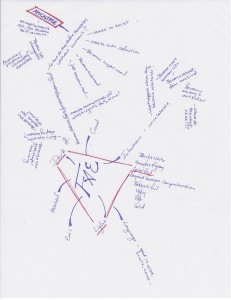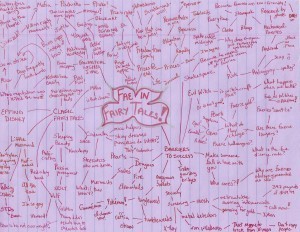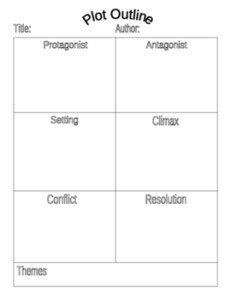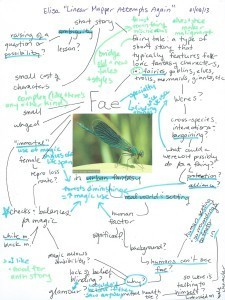Kate Larking's Blog: Anxiety Ink, page 79
September 29, 2013
Revision: How Much Is Enough?

I even edit longhand.
Last week, I talked about why I love revising. This week, I talk about how to know when you’re done.
Some people revise, and revise, and revise. Maybe we’re searching for that mythic perfection. Maybe it’s a way to justify procrastination or avoid facing fears. Then again, maybe it’s something else entirely.
I fall at the opposite end of the spectrum: as soon as I finish a draft, I am buoyed on the wave of how awesome it is. (Or just sick to death of it.) Time to send it out!
Wait! Full-stop. Re-read.
I sent/was going to submit this?!
Yes, ladies and gents, I often jump the gun. I might be a severe, routine procrastination offender, but I am prone to releasing my stories into the world long before they are ready. I dream of one day needing only a single draft to tell a story to the best of my abilities, but for now let me put it this way: I just finished the sixth draft of a novel.
Ugh.
So how much revision is enough? How do infinite-revisors reach a point they can let go, while those like me make ourselves hold on and continue to make is as good as we can?
You will, I hope, do whatever works best for you. But I like to follow some advice I got a few years ago from a Second Life session with Michael Stackpole: ten percent.
First off, get outside eyes. Make that part of your revising process. We are too close to our creative babies to see their flaws. I finished my novel’s fifth draft knowing something was off with the first chapter, but not knowing what. Outside eyes took one look and laid out all the problems for me. (I even fixed most of them.)
And go over your story again and again. Go through as many drafts as it takes until you find you are changing ten percent or less.
At this magical ten percent mark, the changes from draft to draft can only be superficial. Structurally, the story is as sound as you can make it. You’ve patched the worst of the plot holes. You don’t necessarily have the perfect wording (which can change depending on the day, or your mood, or any number of things)* everywhere, but you’re good.
If you whittle yourself down to this point and keep going, please stop. You’re not changing anything significant. It’s painful to watch. Really. Get it out of your hair and get on to the next story. Life is to short to be stuck in an infinite loop.
But if you’ve gotten it down to, say twenty percent – that’s really enough, don’t you think? How much more can that last ten percent really matter?
Trust me: it does matter. You’re writing because you have a story to tell, right? You’ve already put so much effort in, why quit now? Why not tell your story to the absolute best of your ability? Just keep going; you’re almost there.
*Unless you’re working with poetry. I am clueless when it comes to poetry, so don’t listen to me!
September 26, 2013
Plotanser: The Dynamo That is the Writer Who Both Plots and Flies by the Seat of their Pants, or Writing Processes and Why They Matter
The best way I can talk about process is to talk about my own. Maybe you’ll identify with something I bring up and it’ll open up new doors for you. I know realizing how I work has helped me start pieces much more affectively and with a better chance of getting to the end.
For anyone who doesn’t know the major categories of process types or what they refer to, they are:
Plotter: a writer who plots out their pieces and writes guided by an outline
Pantser: a writer who literally flies by the seat of their pants and lets the story take over and lead them
Quilter: a writer who writes scenes individually and later pieces them together.
And then there is me, who had to devise a category so crazy, so new, that it’s mind-blowing! Ok, it’s not really and it’s in one of my subtitles. Talk about anticlimactic. Still, I am a …
Plotanser: a writer who writes a very scanty outline and otherwise lets their piece grow organically, essentially an organized way of flying by the seat of one’s pants.
Now, my definition there pretty much explains what I’m all about. I usually start out with the spark of an idea that I need to get the details down for asap. I’m not a good mind-mapper, but I’m a heck of a list maker. Hence, I write down the very basic info I need to get my story rolling. For me, and maybe for you, they are:
Characters
Setting
Very basic beginning, middle, end OR Why? What’s going on? –essentially the BIG QUESTIONS
I can start a story with a scene, or two scenes, but if I try to work long term like that I completely fizzle out. However, I never ever throw a scene away because who knows? Maybe that scene with Francois battling a depraved lunatic fits perfectly in the story about Stacy who’s found herself in the middle of a vampire war? You really just never know.
Anyway.
In order to see a story to its end, I need to know the fundamentals of what’s going on to whomever, where they are, and why I should care. Otherwise it’s just a bunch of pretty words pieced together for me. Don’t get me wrong though, starting with a scene you really want to write and then plotting afterwards is never a bad idea. I’ve done it. The awesome thing about being a plotanser is you get the best of both worlds (and who’s going to care if you quilt a little while you’re at it?)
After you’ve got the big questions out of the way, letting the story take the lead then going back to plot an outline if you get stuck works really well as a writing formula. I should add in a big ol’ BUT here because they’re inevitable. I’m talking story here, not world building. Right now I’m in the middle of starting what I know is going to turn into a long urban fantasy series, and that is requiring some serious world building. Which means planning. Lots and lots of planning. I want my world to be real, strong, and I don’t want to look back and ask myself what the heck I was thinking.
There you have it, all the info you need to be the best plotanser you can be! Or the necessary details for you to start figuring out what your process is. Try them all once, it never hurts, because working with a process that isn’t really working right for you is going to be stilting beyond belief. Write smarter, not harder!
P.S. If you feel that you identify as a quilter and want some more info, Kate has an excellent post on the topic here.
September 25, 2013
Why Anxiety Ink Means a lot to Me
When we first came up with the name Anxiety Ink, we loved it. If only for the simply reason that every writer is anxious.
For me, Anxiety Ink resounded on a different level.
For nearly 10 years, I have been living with a diagnosis of depression. Specifically, PMDD. For the first portion of my diagnosis, there was a lot of questions about whether or not this really was a disorder, or just an inflated assessment of PMS symptoms in women. However, half of my adult life has been spent with 2 weeks of reprieve between similar-length periods wrought with anxiety, irritability, depression, panic attacks, difficulty concentrating, fatigue….the whole gambit.
I have been on a variety of medications, ranging from herbal remedies, dietary supplements, various anti-depressants, and birth control. Each trial resulted in things like increased symptoms (!!), or vertigo at 3am, or insomnia, or even mania.
After five years of stability, I had to shake up the treatment deck again to maintain effectiveness. There are some months that are far worse than others. Some months make my spouse the enemy, some months everyone else is the enemy. I’m lucky to be surrounded with people who believe in me not only as a writer, but as a person. Because I so frequently do not.
So, in this post, I want to mention some of the quotes that help me as mantras when I need to pick up and fight for myself.
“Live the life you love, love the life you live” – Why yes, I do know that the original Bob Marley quote was for the other way around. However, this one makes more sense to me to immediately make my day better because it will make me love the life I am living. Take the time to write if that is what makes you happy. Take the time out for you. Honour yourself.
“This too shall pass” - You bet it will. Just calm down and let it fall away. Rejection? Send out the next one. You will always have new work, new ideas, new presses to send to. Don’t invest all your worth in one event–you are so much more than that.
“Do more of what makes you happy” – Let go of that other stuff that bogs you down. Do what makes you truly happy. Even if it’s uncomfortable at first getting back into the groove, even if you doubt yourself, even if what you think you are writing is horrific and should never see the light of day. You will appreciate it in the long run. Let the feelings out and let them seep into your words. You’ll be surprised at the power those words hold later.
September 22, 2013
Revision: How To Love It
Maybe I should title this post “Why I Love It” instead. No matter what, some people will always despise this part of the process.
It can be daunting. You have the whole manuscript sitting in front of you. Writing the first draft was painful enough; why should we have to both revisit that pain and inflict new? I mean, you’re ripping out parts of your baby!
And what happens if you rip out the wrong parts?
Revising can be tedious. I have spent weeks on a single chapter (mostly because I kept putting it off and getting distracted, to be completely honest). When a brand new story is calling your name, how can you justify that time on an old one?
Confession #1: I am ruthless with my own work. The more red pen I see on the page, the happier I am. If it’s not there, I feel like I’m doing something wrong.
Confession #2: I often do find editing daunting and tedious and overwhelming. But then I remember how much I revel in the feeling of making my story better in a tangible way.
I also have a method. Most writers I know have their own approach that is nothing like mine. Some need to have a different approach for every story, every draft. But I figured out what works for me by finding out all I could about how other writers revise and edit, then just doing it for myself.
My method first requires that I print out the story. The whole story. (And when the story has a word count that exceeds 100,000, that’s a lot of pages to print.) I tend to procrastinate a fair amount, just on this first step.
Then I read it through as quickly as possible – preferably in one or two sittings. I sometimes make notes as I go along, but I don’t want it to slow me down. The speed can help trick my brain into full reader-mode, as opposed to writer-mode. This is when I see the big things, like the major plot points that are too deus ex machina, or giant plot holes. This is the step at which I am better able to see if I should add, delete, combine, or move scenes.
Example: in my current project, my read-throughs showed me that I needed to add certain characters, entirely remove certain others, and even combine two into a single person. Revising for my fifth draft, I even discovered that I had to add an entirely new race.
But after my read-through, I have to buckle down and put red pen to paper. At this point, I take it one sentence – sometimes just one word – at a time. And bit by bit, it gets me to the end. And the end is an amazing feeling.
September 19, 2013
A Frustrated Take on Mind-Mapping Part II.
This post might make more sense, or you might relate a bit more, after reading Part I as well as Kate’s mind-mapping post.
Ta da!!! Here is my second attempt at mind-mapping:
Ok, this round was much better, probably because of all the ideas sparked in my first attempt and all of the little lessons learned during that failure. First, I found a pretty picture to be the epic centre of my mind-map because I wanted to. Second, I decided that my topic was Fae in Urban Fantasy because UF is the genre I’m currently trying to work in and where I want to stay for the time being. Next, I started out by defining what a fairy tale is because that’s how I work. It’s the itty bitty scientist in me who likes to do that because I don’t allow myself to be sidetracked from a definition. Then I took a break to let my brain haggle out some details. Finally, when I sat down pen in hand, I set myself a 10 minute timer because I spent WAY too long on the first one.
The 10 minute cut-off was surprisingly effective, I knew I needed to work fast and not get bogged down by pretty-ness, major details, or connections. I was able to just let the little things flow and I wrote down everything that popped into my head. Everything in black was done within the 10 minute time frame, I went back with my blue highlighter to pick out the ideas I liked the most. I then carefully read what the anthology we are all writing stories for wants since I started both mind maps knowing only that they want short stories about Fae in Fairy Tales. The green highlighter reflects what the anthology is looking for that I didn’t already have down –it’s always an awesome coincidence when what you want to write is what someone is looking to read! Generally speaking of course. The tip about highlighting later was a good one.
Despite Kate’s How To about estranging yourself from your main idea, I find I don’t like to get too far away from my centre idea because I worry I’ll get lost or unfocused. But you might not work like that. Personally, I don’t need a million avenues to think about before I start writing, I don’t think I’d ever finish a story. But if you come at the mind-map with nothing I think it’s a brilliant thing to do. I started this all with an idea sparked with just the topic given to me and a UF world I’m already working on (thankfully).
After performing two attempts, I think this mind-mapping deal might have some promise. I can’t say it’s my favourite form of idea sparking but I think I could easily resort to it if I found myself stuck. My major issue is I just don’t work visually, I work with information. If you find yourself wanting to smack your head on your desk trying to do this you’re probably like me and you should find a different form that works for you.
In Part I, I mentioned that instead of mind-mapping I make tables, I scribble paragraphs, and I do point form. If any of those sound like they’re up your alley, try them! Experimenting never hurts.
September 18, 2013
Plotting Style – Quilter
I have never found myself fitting into the profile of either a Pantser or Plotter. For a quick recap, here are the definitions:
Pantser: Someone who writes by the seat of their pants. If they know where the story is going beforehand, where is the excitement in writing it?
Plotter: Someone who utilizes outlines, character profiles, documents worldbuilding before writing the main novel. If you don’t know where you are going, how will you end up with a usable product?
While both are valid and both sometimes intersect (let’s face it, characters are notorious deviants), I have never felt like I fit in the two. I have scenes in my head and I can order them in a way that makes them plotfully sound, but do I really fit into one category or another?
It wasn’t until When Words Collide 2013 that I realized there was a third type that I actually really identified with. Meet the dreaded QUILTER!
Quilter: Someone who writes scenes, arranges them into their story, and revises them together.
Seriously. Why did I not know that this style existed? Why did I not embrace my style enough to give it a name as awesome as quilter?
As new writers, we are inherently insecure (If we’re not insecure, we are delusional). Writing is seen as a science that others have mastered and summarized into writing magazines as various 3 through 8 step processes. Character development? Answer these 4 easy questions! Plotting? Use the 3 Act structure, 5 Act structure, 8-step plot development! Building tension? Remember these 5 things.
We rarely take the time to go back to the core of ourselves and follow what initially worked.
The most important thing of writing for a new writer is the first draft. Why? Get your butt in that chair and do it. Do whatever it takes to get it down, written. Presentable? Doesn’t have to be! Revising in a framework of text is much easier than getting the words down onto the naked page. Then you can worry about, “Are all the aspects of my character there?” Or “Have I clearly conveyed her emotional state without being too literal and telling readers?”
I write scenes from all over, save bits and pieces from various drafts, and then I sew them together into one draft. With that draft, I revise with a balance of action and tension, character development and emotional destruction (not everyone will have that last bit in there. I’m really mean to my characters).
Does it matter if you fit any of these three? No.
Just write.
September 15, 2013
Mine Is A Twisted Mind To Map
Read Kate’s mind-mapping challenge here, and Elisa’s response here.
Here’s the thing: I don’t often sit down with the intent of brainstorming. Sometimes, I’ll have an idea for a story, but it’s not enough by itself. When this happens, I put that story on hold and wait for it to grow. And it does. If it’s not ready, there’s no sense in forcing it.
I have to admit, I wasn’t sold on the idea of doing mind-maps. Maybe it’s because when I first learned about them in second grade, we called them webs, and I was severely arachnophobic. Not the best combination.
I also don’t remember them working that well for me, though it had been quite a while since I last used one.

There is a story here, but I’m not telling. Yet.
Confession: I did re-draw it. Not to make it look prettier (necessarily), but because the original is about a third of the size and would have been completely unreadable. I didn’t change the words or the placement.
Just “Fae” is ridiculously broad, so I started by naming overarching ways of portraying them, then latched on to what most appealed to me. When one avenue seemed to peter out, I took another. I found that some of the themes related back to each other, even when starting from disparate points. I didn’t fill the paper; I took just as much space as I needed.
In the end, I’ve laid the ground work for a short story. It is one of those ideas that will challenge me and force me to grow as a writer, so it intimidates the hell out of me. It lies somewhere in the valley of not fleshed out enough, outside my comfort zone, beyond my current skill set, and requiring more focus than my scattered self can currently muster.
As with anything creative, you have to trust your gut. My gut is telling me that this story will be a crucible for me as a writer, should I ever see it through.
That thought makes me want to run screaming in the other direction. (But if I’m going to run screaming, might as well aim straight for it!)
Thank you, Kate, for the challenge. I doubt this story would have been born without it. I needed the reminder that trying new (or re-attempting old!) approaches is always a worthwhile experience.
September 12, 2013
A Frustrated Take on Mind-Mapping Part I.
This post ties in with Kate’s previous post on mind-mapping since she initiated a challenge!
I remember in high school English the incessant need for teachers to assign mind-maps, especially in association with group projects and presentations. I remember rolling my eyes then and wondering why I needed to waste time better spent on the relevant parts of the project. Now, having completed my Fae in Fairy Tales mind-map (because Kate made me), illustriously titled “Mind Map of the Linear Soul,” I have learned, re-learned, and realized a few things:
I am far more linear than I thought. I pride myself on learning and thinking in multiple ways, my flexibility is one of my greatest assets, but thinking and learning visually like this is one of my weaknesses.
I get very irritable when I don’t know more about a topic than I thought. This is something I have re-learned. I am one of those people who likes to know a little bit of everything, I hate being in the dark.
I don’t like mind-mapping now any more than I did four years ago. Arg.
There is a serious lack of fae in today’s pop culture! What’s with all the Fairy Tales and no fairies?
I may have to take Kate up on her offer of mind-mapping therapy. Maybe. We’ll see how my patience holds up.
I am not a quitter, so I’ll do another mind-map, but I’m going to pout the whole time. So there.
In a nutshell, I sat here wondering why I wasted my time on this mind-map disaster I created when I should have quit after struggling to remember Cinderella had a fairy godmother. I could have been writing! I’m definitely sitting here thinking: “Wow, Kate. Really? This was horrible.” Look:
I was completely unable to connect my own story ideas at this stage. But, like I said, I’ll try again. And below are a few reasons why.
I am 100% in agreement about incubation! I refer to it as percolating (thank you, Two and a Half Men), but that’s merely semantics. The main thing to focus on is that your subconscious is a million times better at recognizing patterns and figuring out puzzles than your conscious is –at least that’s my experience.
When I get stuck or feel as though I have an idea but it’s not quite there, I lay out my ideas in paragraph or point form (put the grounds in the coffee machine) and hit my brains the ON switch and let it get to work. Eventually, ideas and connections trickle out and I’m left with a sweet carafe of potential story. If you don’t work well like this though, mind-mapping is the way to go.
I find mind-maps distracting and confusing because I like to see everything clearly –hence my love of neat paragraphs or points for my story ideas. Tables work really well for me too because they’re clean and I can locate ideas I want without having to comb through a bunch of lines and words. I do use arrows and margins if I want to branch off ideas, but again, it’s all about easy locating for me.
Mind-maps are also overly time-consuming for me because I like my visual items to be pretty and I can’t stand it when they aren’t. It’s an OCD thing. If I do it fast, it’s ugly (yes, my first mind map is atrocious), and I won’t want to look at it when I’m done. But, if I take the time to make it beautiful, I’m not letting my brain focus on the important details.
Do you see my dilemma?!
Still, I am not a quitter and I will persevere! I am going to attempt a second mind-map, except this time, instead of focusing on the innocuous “Fae in Fairy Tales,” I’m going to centre my story idea and see how that goes. And I will be following Kate’s How To’s and Tips and Tricks because I think they’re pretty great. I’m just going to let the creative juices flow –wish me luck…
September 11, 2013
Why Mind-Mapping Can Save the World!
Okay, maybe it won’t be able to save THE world but it can save your world! Let’s face it, all writers get stuck. All of ‘em. Sometimes you get stuck in the beginning when you are just formulating an idea. Other times, you need to revise and help get yourself unstuck from a sticky situation.
If you know you’re stuck and you’re staring at your document trying to think of answers, try a mind-map!
Mind-maps appeal to both visual and linear thinkers. Visual learners don’t have to fit everything on staggered lines and linear thinkers can outline the ideas after into a standard format. By branching outward, you can uncover ideas that are more obscure in relation to your original idea. This will help you explore unconventional associations to the central idea. You might even pull a few free-associative ideas that don’t directly connect back to your central idea–and that’s okay! Just go with it.
Will your map be pretty and visually pleasing when you’re finished? If it is, you’re freakishly talented. Mine are messy and flawed, complicated and scribbled. What matters is the ideas are there and you find diamonds in the rough of your mind.
HOW TO MINDMAP
In the center of your mind-map, write down the central idea or word that most resounds with the issue where you are stuck.
Next, branch off this idea with words, ideas, or terms that generate from that central idea.
Next, treat each branch as its own center and branch off that word or idea with new terms and ideas. There might only be tangentially related to the central idea or they might still seem directly related. Don’t judge the ideas–just keep branching out!
The further you get away from the center, the more estranged the ideas will become. Maybe you’ll get so far away that the next idea is the complete antithesis to the central idea you started with. And that’s okay! Just keep building.
TIPS AND TRICKS
Set a timer. A timer will force you to focus on the mind-map and keep drawing. Best timeframes to work in? Probably around 5-10 minutes. You might find that 7 minutes is that sweet spot to get the right amount of ideas. You might find that 10 minutes means you are writing as tiny as possible to make sure you stay on the page. Just focus on the mapping.
Turn the paper sideways. Seriously. Seeing pages differently can elicit different ideas. Literally, write against the grain of the paper.
Change it up. If you find you normally star branching on the left, try branching initially from the top, bottom, or right. Changing the direction, even for the initial point, can keep your brain stimulated every time you map.
Use colour. Use coloured pens different from your writing and editing pens. If you plan to do a different colour every level of depth you get away from the central idea, perhaps write in black to the begin with and then highlight the terms later. Switching pens and counting how many layers you are out while mind-mapping can slow your progress and keep you engrossed in other things than needed to diverge your thoughts.
Branch off images or art. If you are inspired by a piece of art, print of a miniature of that art and place it in the center of the map. Branch off the image and see where ideas take you. Look at colours, shading, faces, angles, textures etc! Even if a part seems tiny, branch off of it. It will add nuances to your ideas.
Type it up. After finishing, if you are a linear thinker, feel free to type up your mind map for reference later. Tab in your levels as you get further away from the central idea. You can also do this if you aren’t sure you can read your scrawl and generally messiness later.
Embrace incubation. You might finish your mind-map and have the perfect answer right away. If you do, fantastic! But you might not. You might be holding your pen over your mess and think, “Wow, Kate. Really? This was horrible.” All is not lost! After reviewing your mind-map, take some time off to let your subconscious mull it over. Believe it or not, your brain will think things over when you’re not. You know how you find things when you’re not looking for them, after you spent the entire morning FREAKING OUT? Exactly. Let your subconscious work. It might be a few hours, it might be a few days. – Round two! Come back and do another mind-map. Compare it to your first one. See what’s different and what’s recurring. Take either a recurring topic or a new one and mind-map with that. See where you go.
Let go. There is no wrong way to do this. Relax, and have fun.
WRITERLY APPLICATIONS
Generate anthology ideas. Often, those writing for an anthology will take the first idea that comes into their head. That idea might be fantastic…but you might be worried is over-done or the editor will receive a handful of ideas on a similar premise. Take the central idea and branch out from it. Even if the original idea is more obscure, you will find a more unique idea if you take a step back. Often, these step-back stories have more marketability if you don’t make it into the anthology but still want to sell it.
Build Worlds. Write the name of your world and some keywords. Economics? Social Structure? Food? Arts? Build off from there and see what ideas you get to make your world as fully flashed out as possible.
Murder writers block. Get more divergent ideas and see where they take you!
EXAMPLES
That’s right. I challenged the 3 of us to mindmap on the same topic. The results are forthcoming….except here is my jewel!
We all mapped on the same topic: for an anthology involving fae in fairy tales.

Click to see the full version!
September 8, 2013
The Extroverted Writer
As a follow-up to Kate’s post here on introverted writers, I want to talk about the extroverts among us. Not that there’s much more to say; she covers it fantastically.
Because the physical act of writing is usually such a solitary activity, I think the typical image of a writer is the hermit alone in the woods, removed from society…
Nope, sorry.
Speaking as a writer of fantasy, that’s just not realistic if I want my stories to be at all relatable to anyone else. (That’s a whole other post.) Whether I like it or not, I have to go out and interact with real, live people. But you know what? I think that part can be a lot of fun.
No two artists approach their craft the exact same way. We all have our strengths and weaknesses; the trick is in finding our own and playing to them. Most extroverted writers I know wear many hats: actor, musician, EMT, to name a few. Consequently, they bring that diversity and complexity to their stories. Extroverts are not better or worse writers than introverts; just different. Which is good for me, as I am completely neutral between the two.
A lot of the world — at least Western society — has a biased preference for extroverts, so maybe those who identify as introvert are digging in and carving out their niches. The problem lies in the misconceptions perpetuated about both sides.
Quite frankly, I don’t get it. Some people are energized by social interaction, some by solitude. That’s it. The end!
Certain quirks and personality traits tend to be attributed to one side or another: extroverts as loud, outgoing, and boisterous; introverts as quiet and shy. But those aren’t always the case. We all worry about meeting new people, about making fools of ourselves; we all feel shy and insecure at times.
I’ll let you in on a not-so-little secret: whatever you are, it’s ok to be exactly that.
Anxiety Ink
- Kate Larking's profile
- 53 followers









